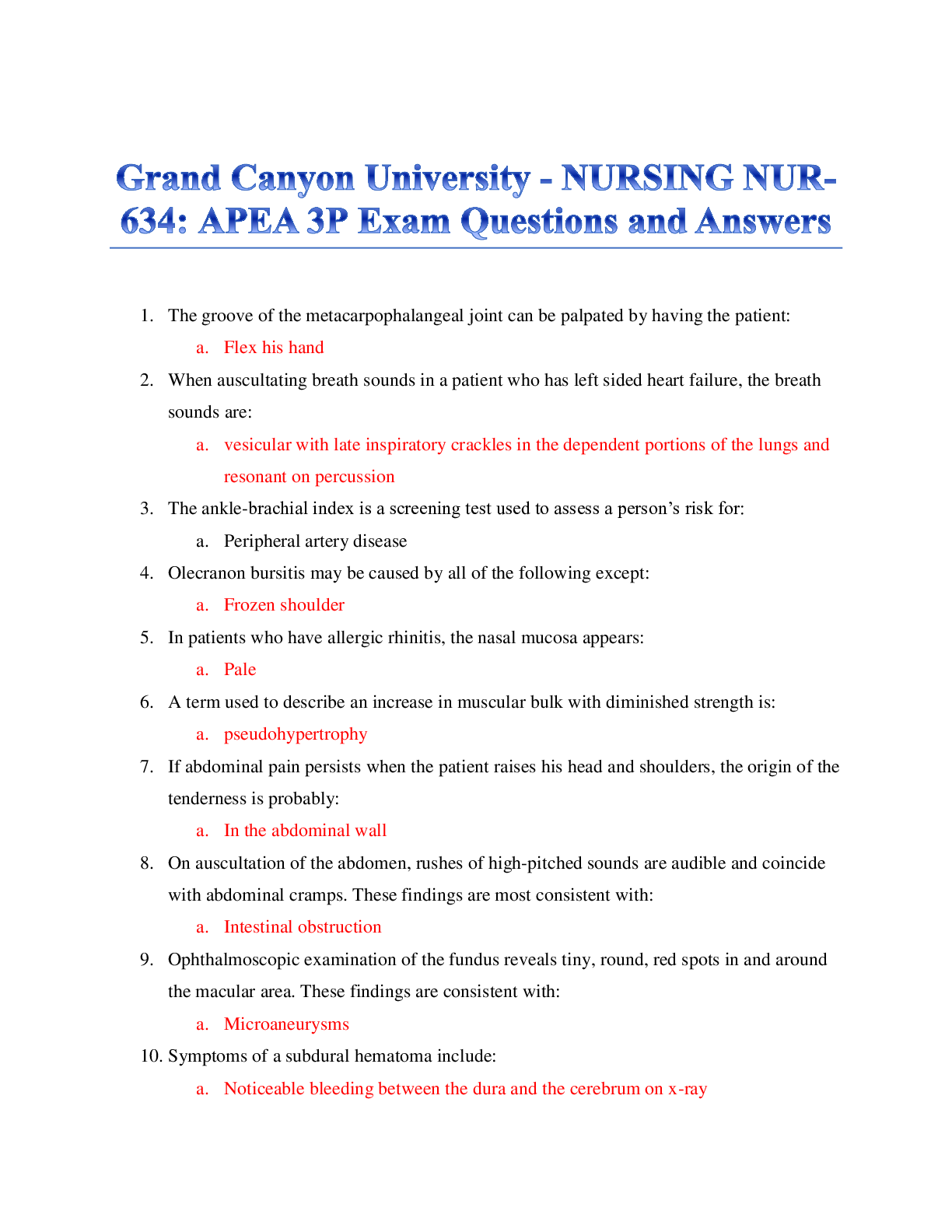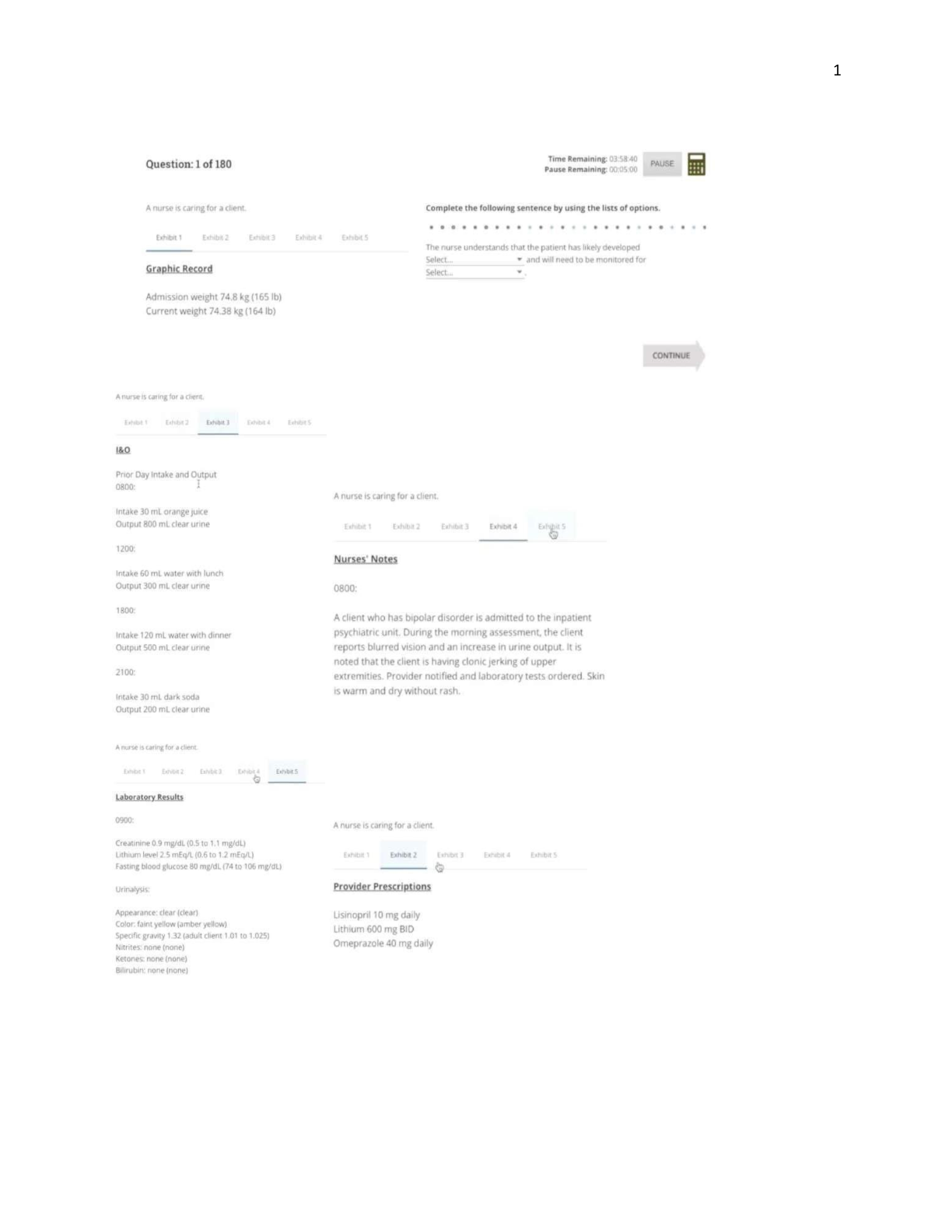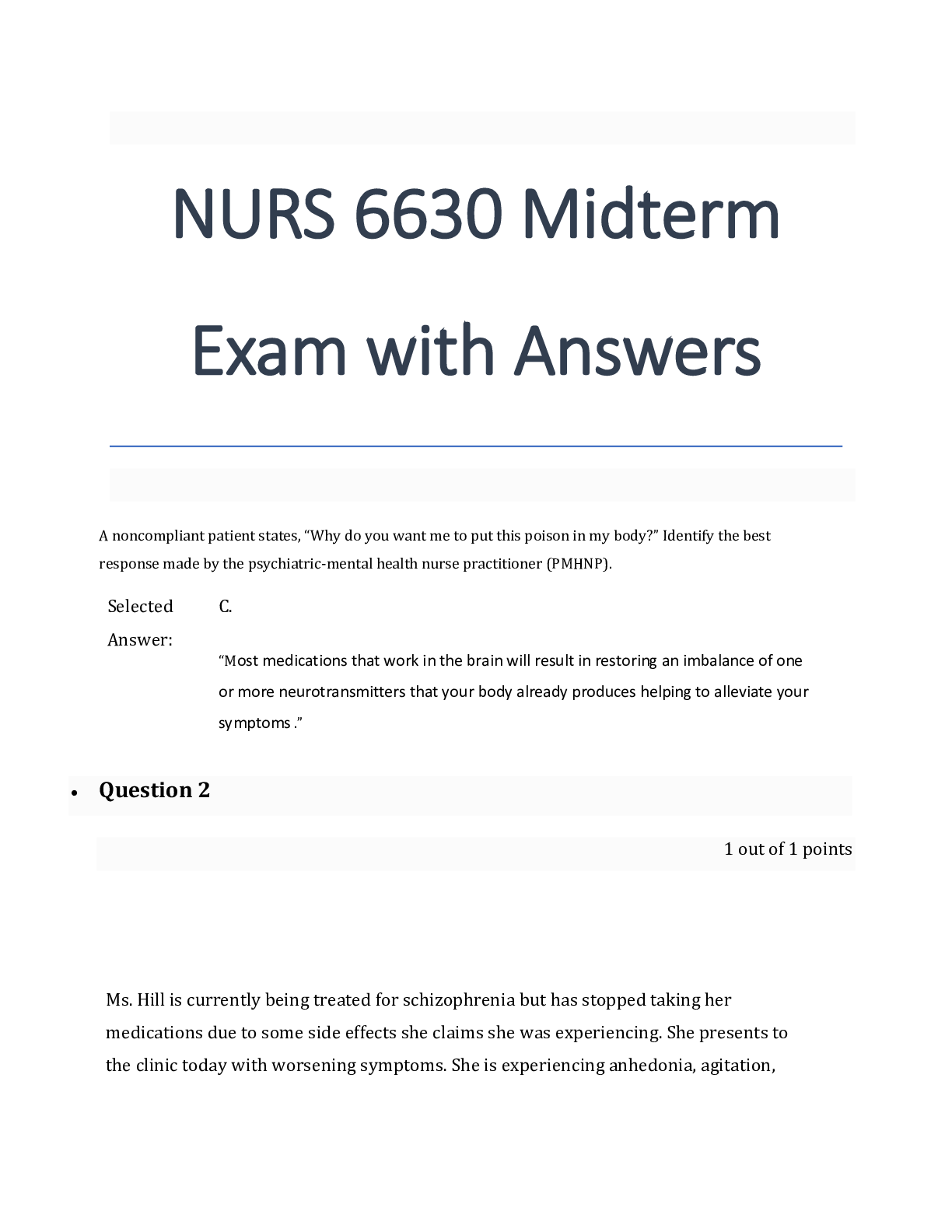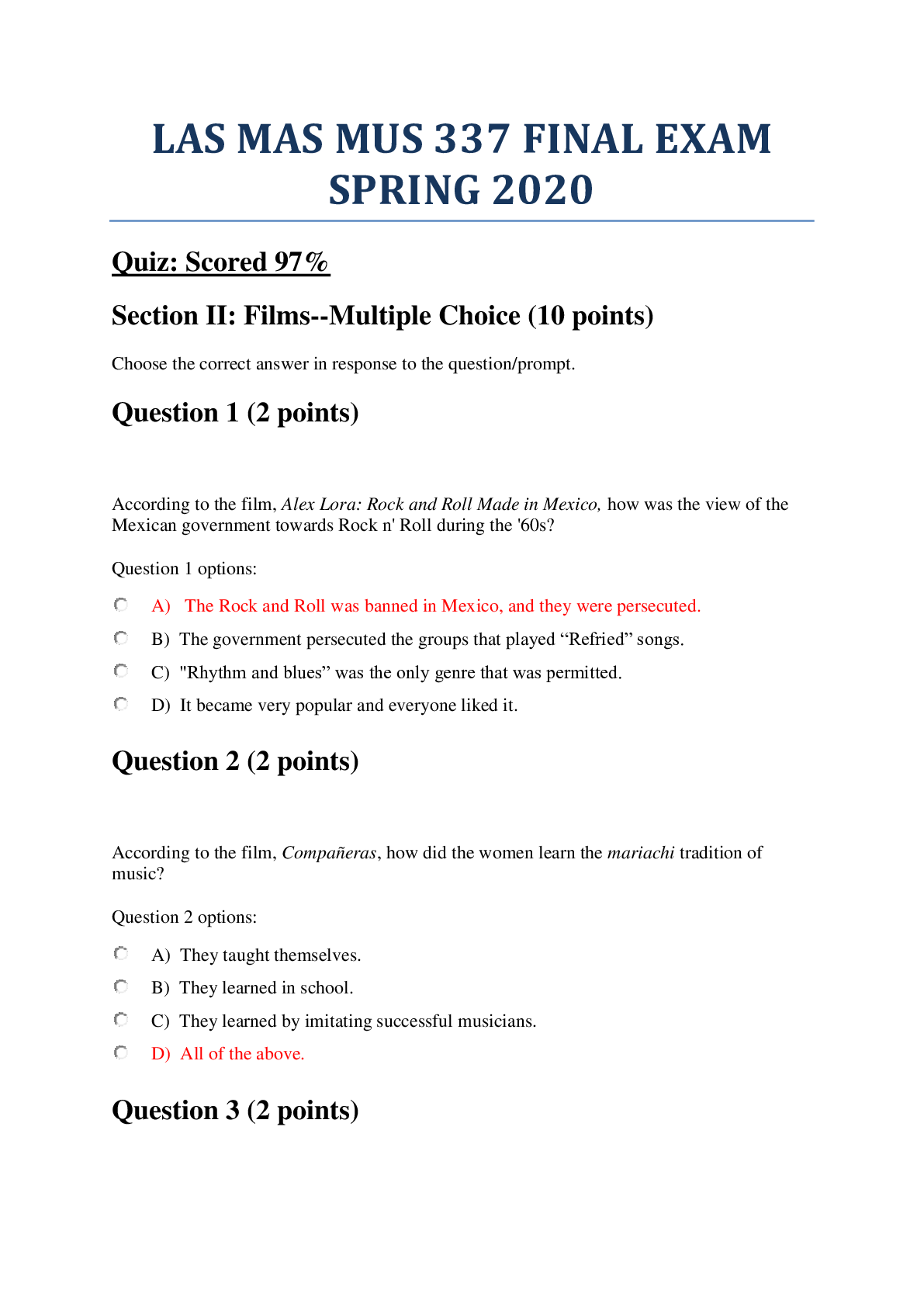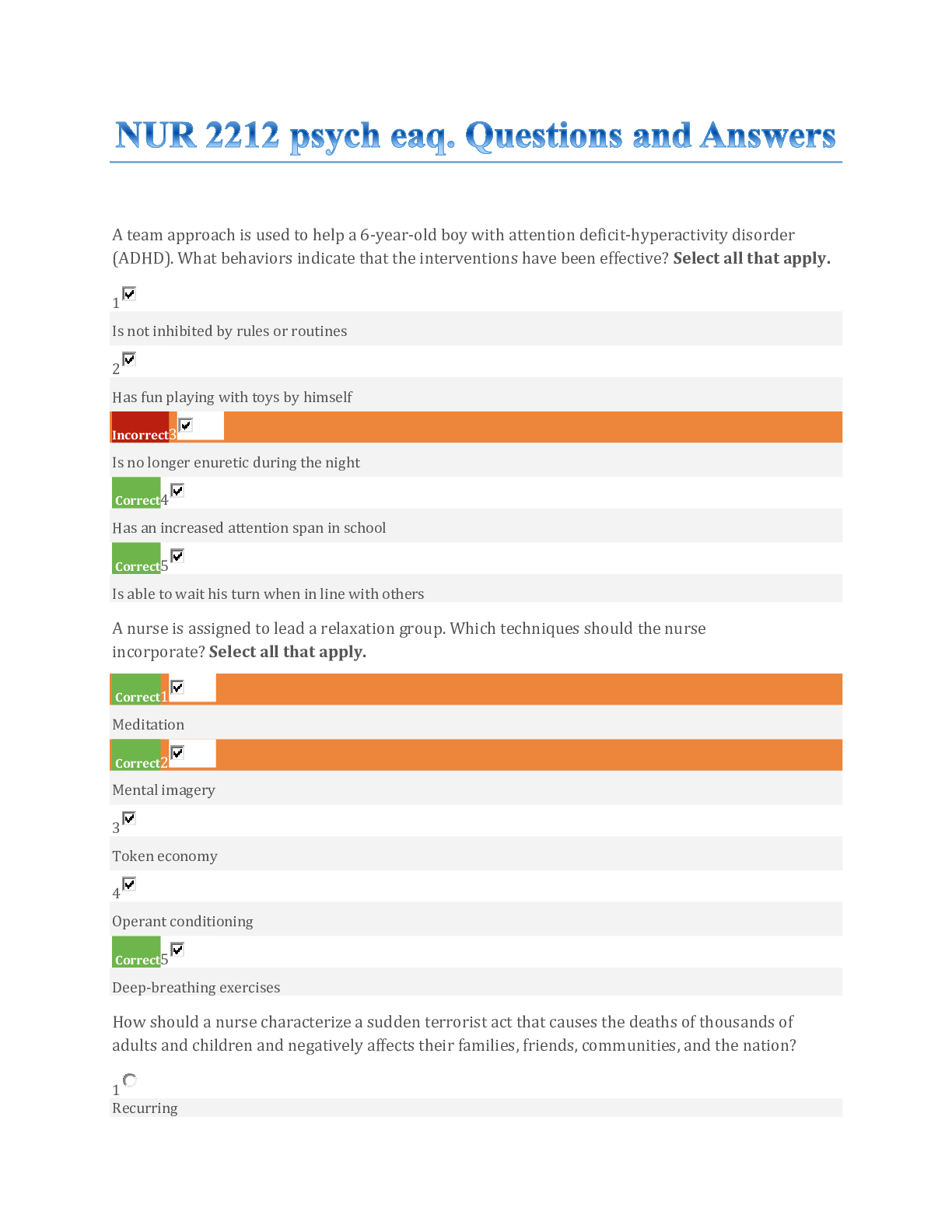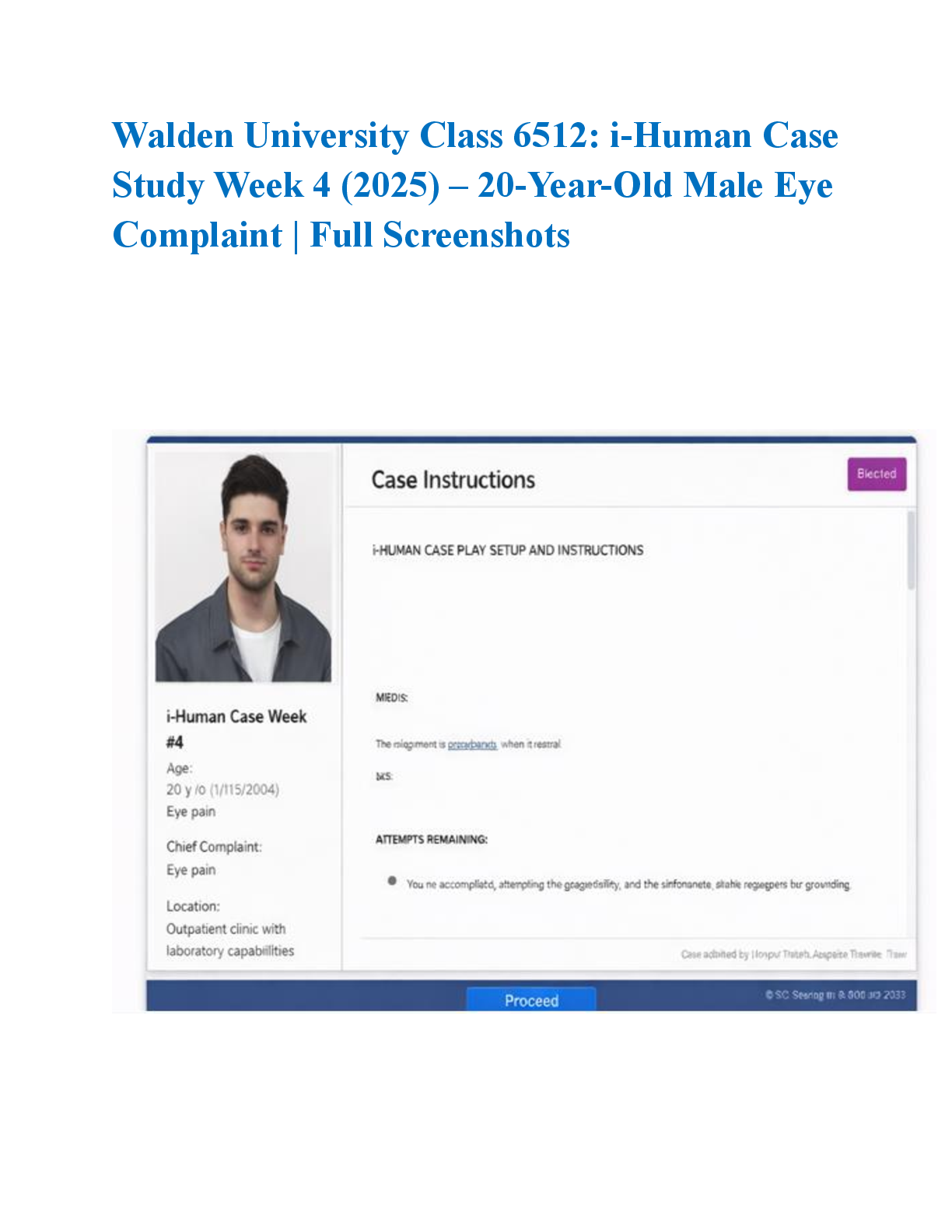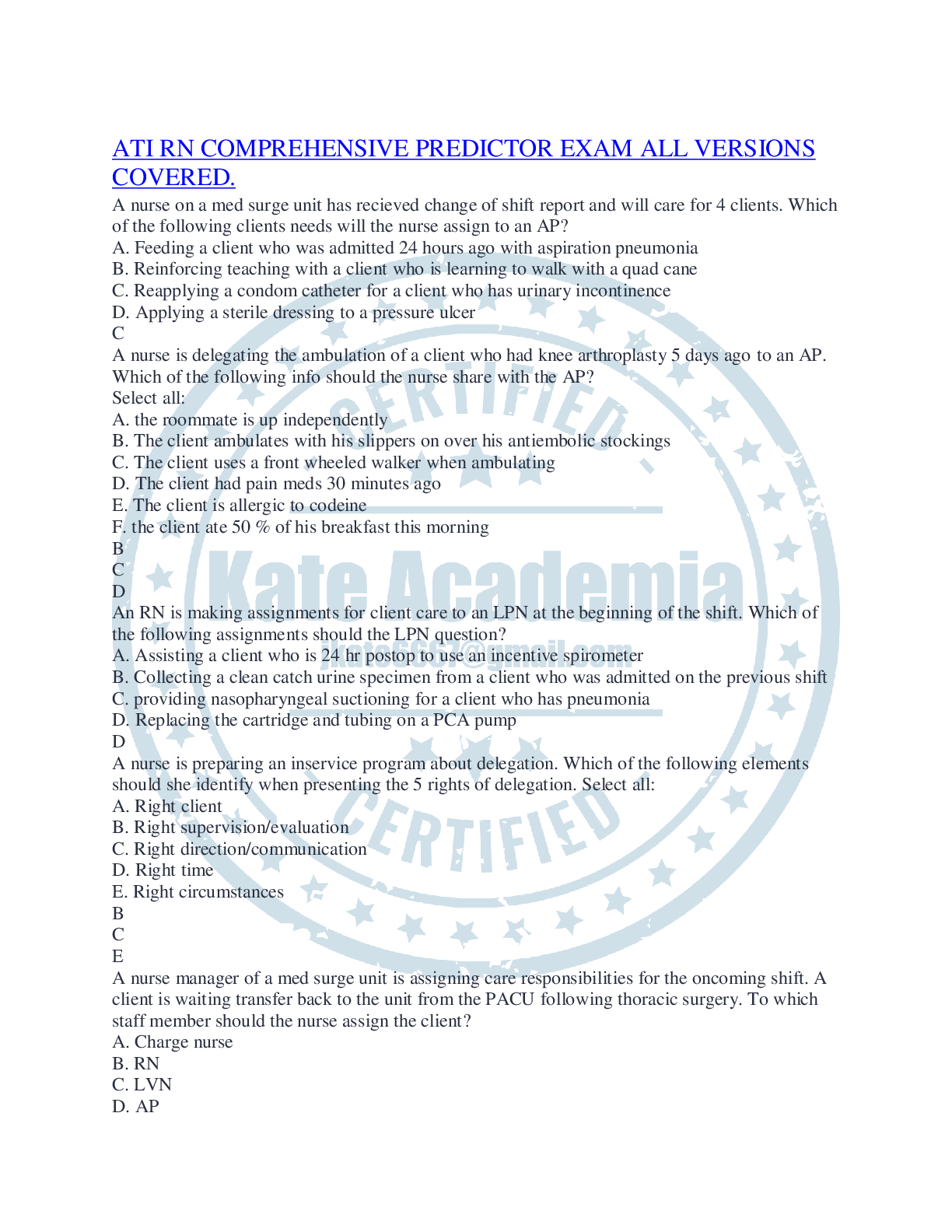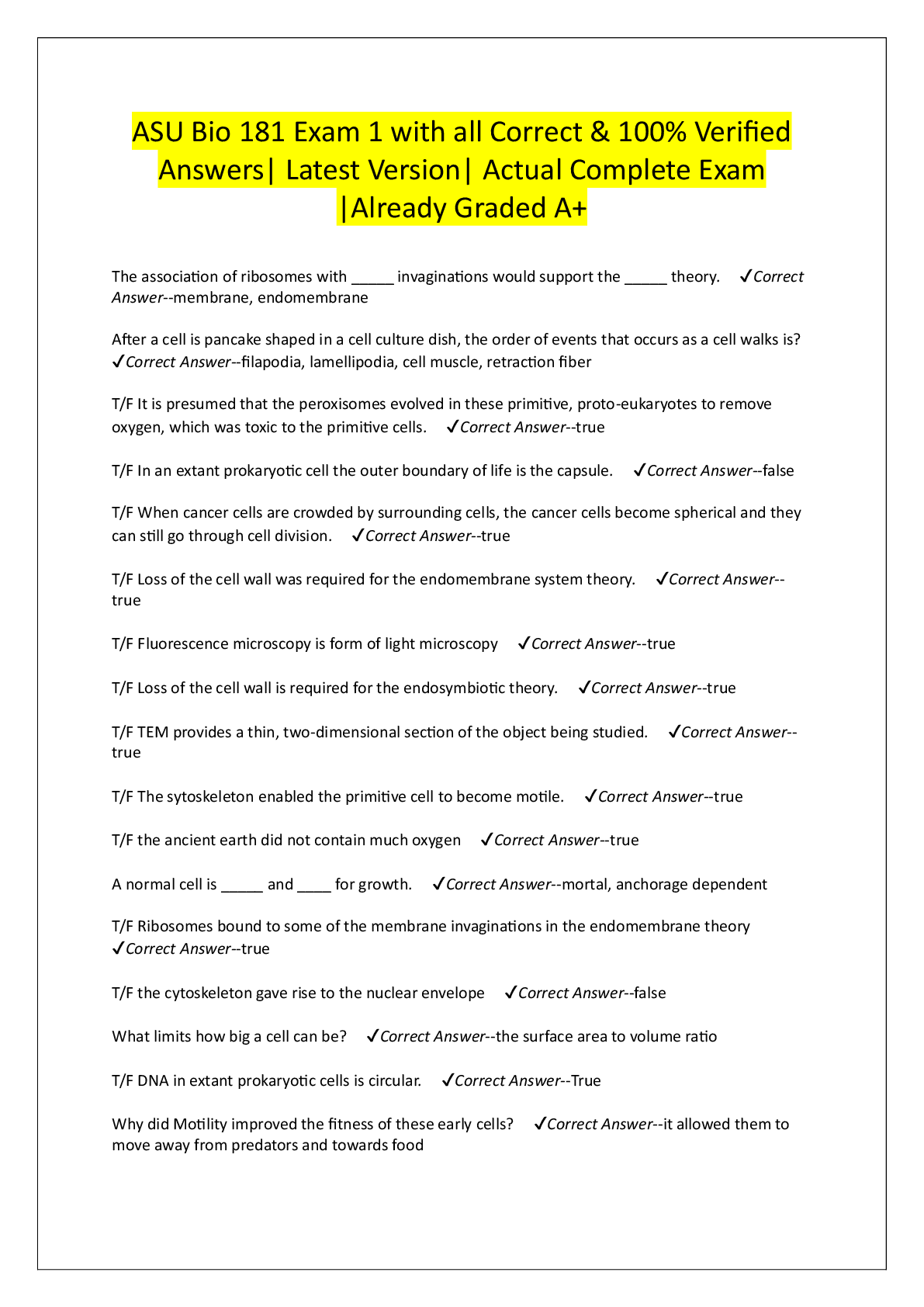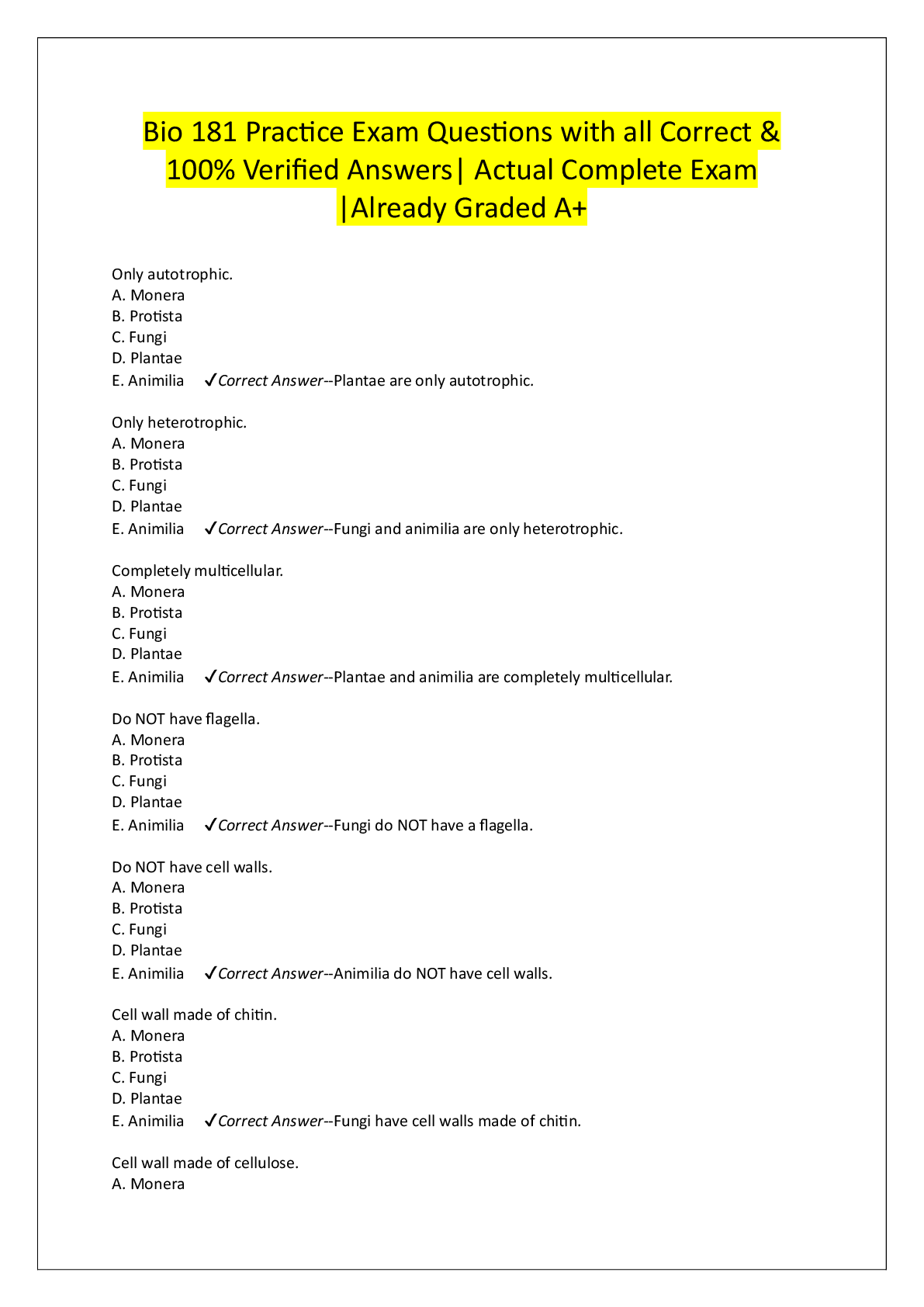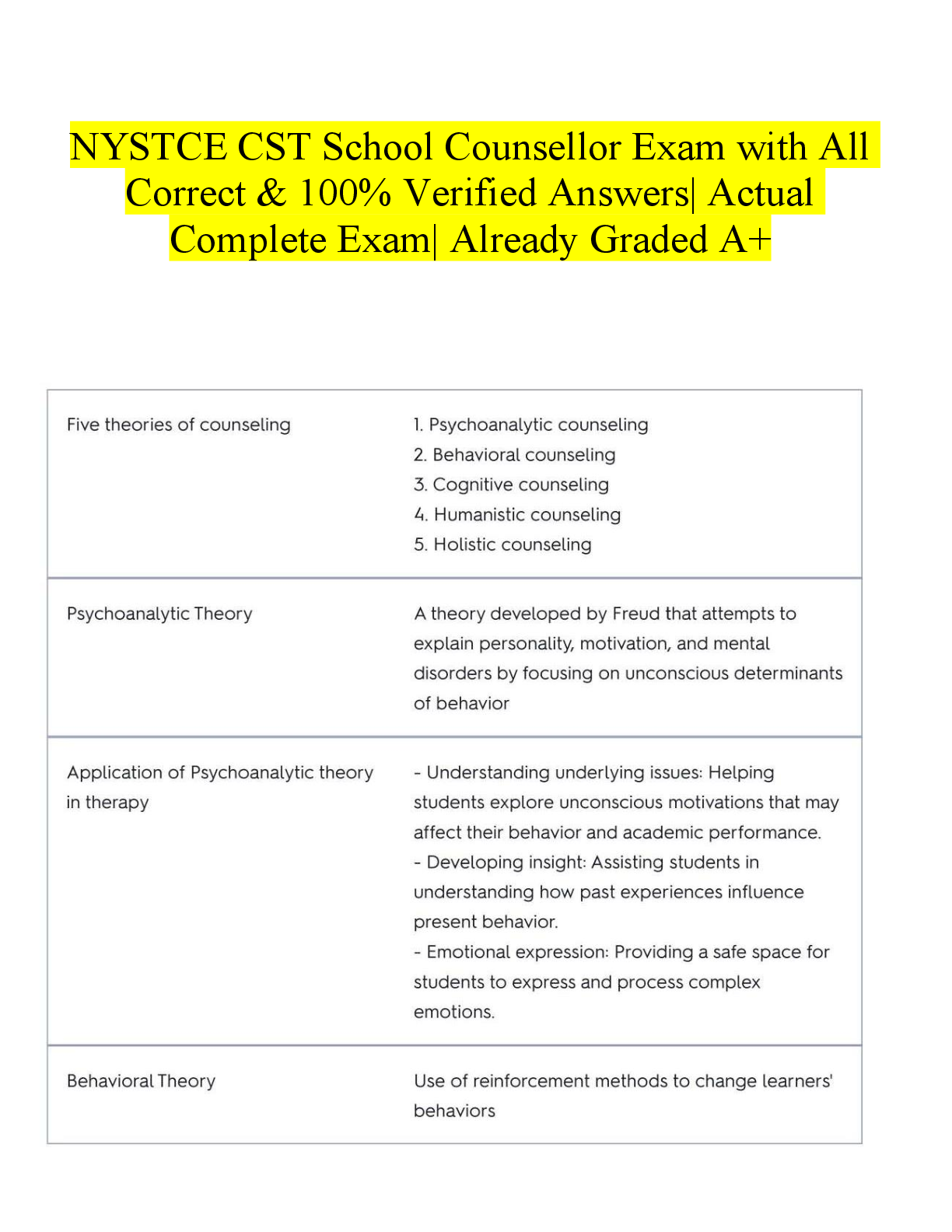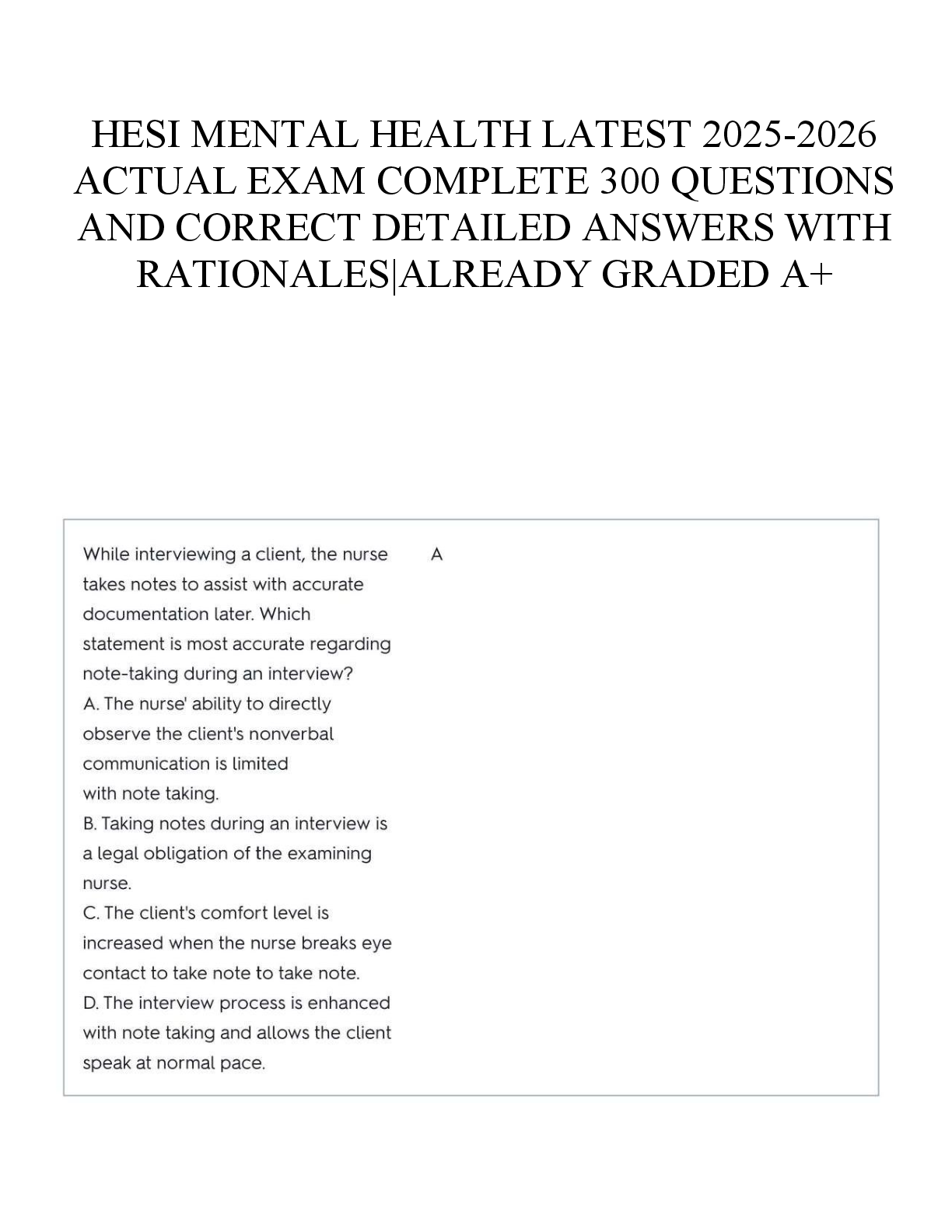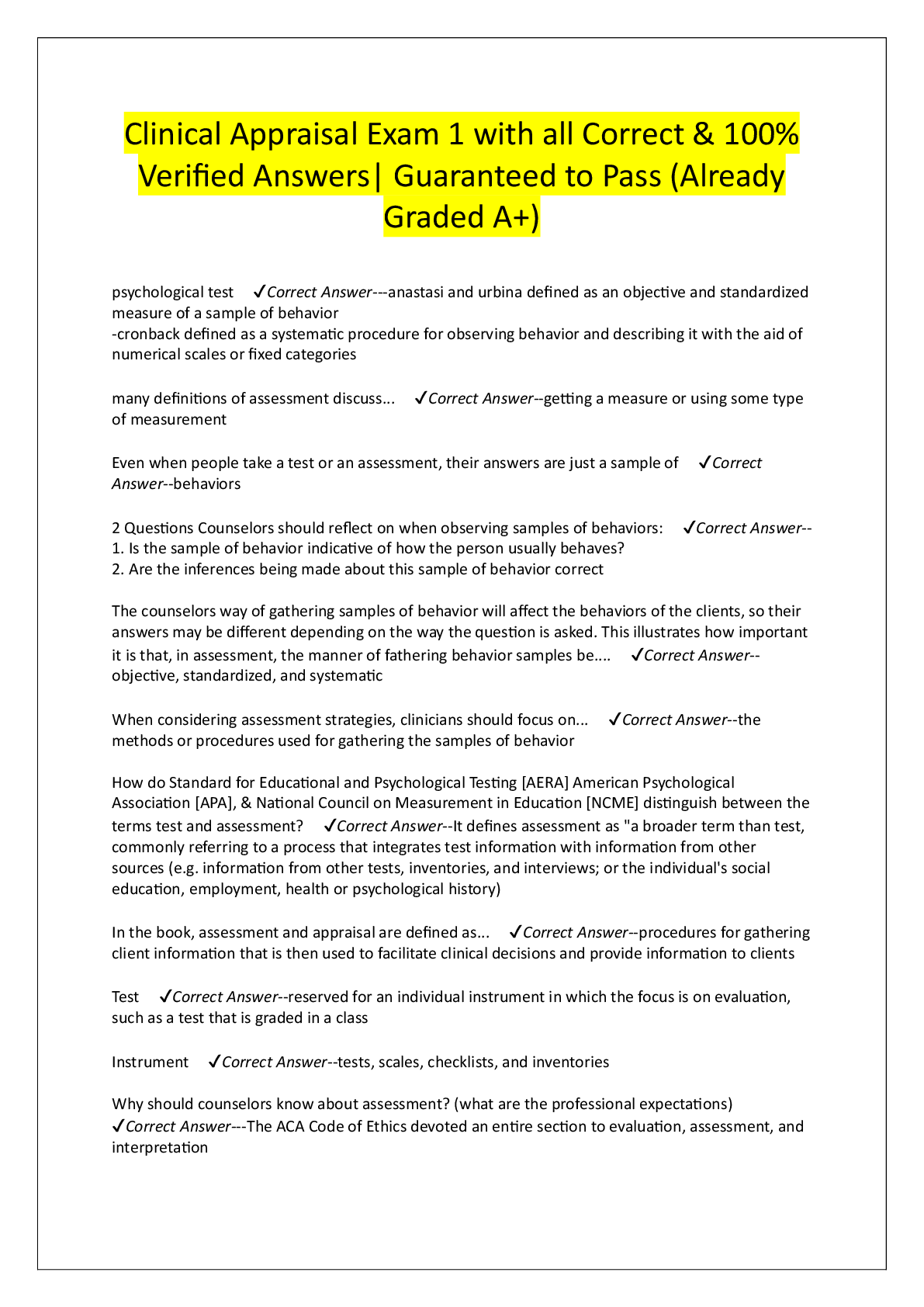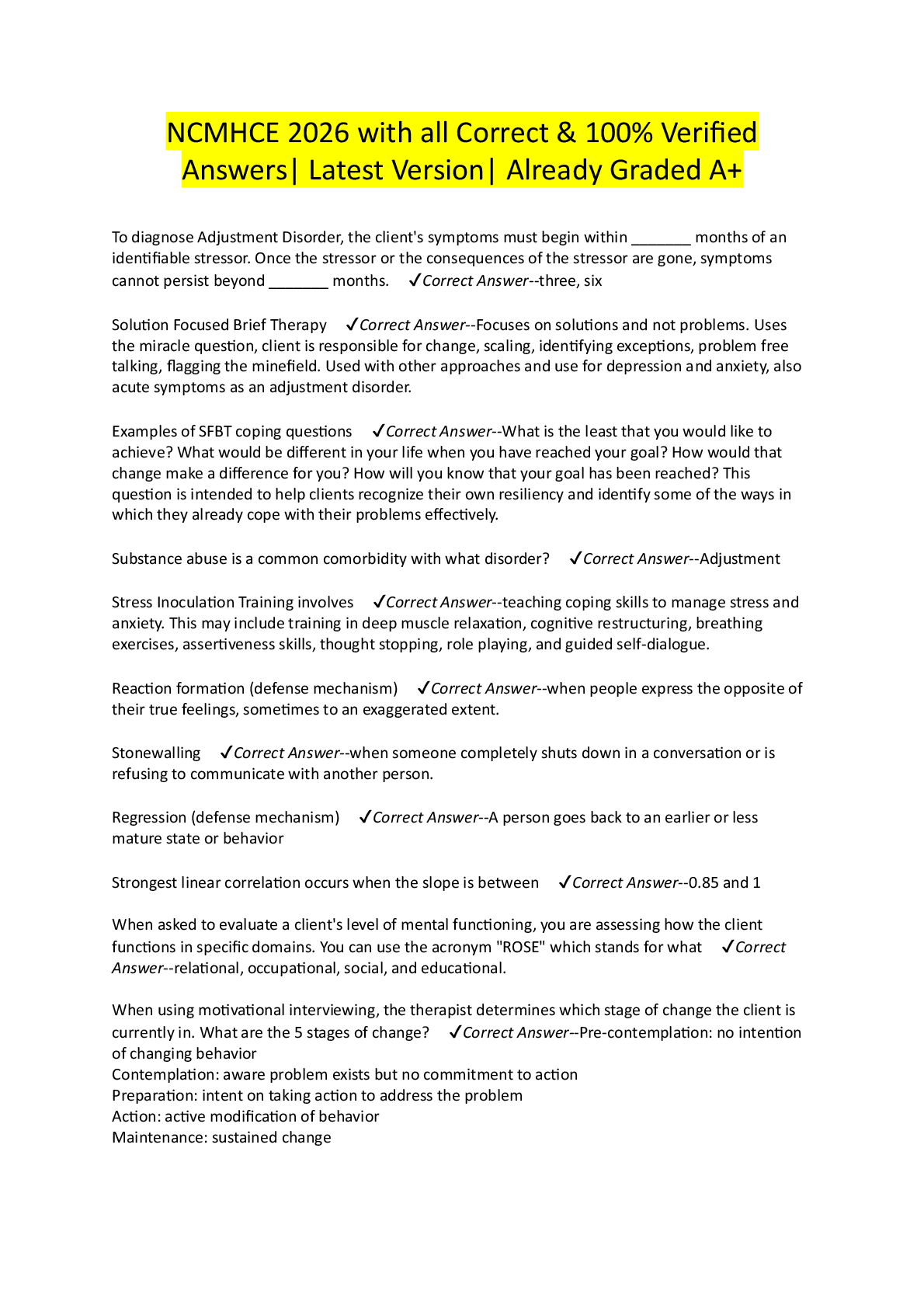*NURSING > EXAM > 2020 NCLEX-RN TEST PREP: BASIC NURSING CARE (STUDY MODE) PRACTICE QUESTIONS WITH: ANSWERS & EXPLANA (All)
2020 NCLEX-RN TEST PREP: BASIC NURSING CARE (STUDY MODE) PRACTICE QUESTIONS WITH: ANSWERS & EXPLANATIONS
Document Content and Description Below
TEST MODE: PRACTICE EXAM QUESTIONS BASIC NURSING CARE (TEST MODE) 1. In which of the following ways can the nurse promote the sense of taste for an older adult? a. Mix foods together on the di ... nner tray b. Avoid cologne, air fresheners, or room deodorizers c. Encourage the client to chew food thoroughly d. Discourage the use of salt or seasonings with prepared food 2. Which of the following is classified as a prerenal condition that affects urinary elimination? a. Nephrotoxic medications b. Pericardial tamponade c. Neurogenic bladder d. Polycystic kidney disease 3. A nurse is assessing an African American client for risks of a pressure ulcer. Which of the following best describes what the nurse might find with an early pressure ulcer in this client? a. Skin has a purple/bluish color b. Capillary refill is 1 second c. Skin appears blanched at the pressure site d. Tenting appears when checking skin turgor 4. A term used to refer to generalized wasting of body tissues and malnutrition is called: a. Entropion b. Confabulation c. Induration d. Cachexia 5. Which of the following clients is at a higher risk of developing oral health problems? a. A pregnant client b. A client with diabetes c. A client receiving chemotherapy d. Both b and c 6. Which nursing intervention is most appropriate to reduce environmental stimuli that may cause discomfort for a client? a. Loosen pressure dressings on wounds b. Use assistance to pull a client up in bed c. Check temperature of water used in a sponge bath d. Position the client prone 7. A client has developed a vitamin C deficiency. Which of the following symptoms might the nurse most likely see with this condition? a. Cracks at the corners of the mouth b. Altered mental status c. Bleeding gums and loose teeth d. Anorexia and diarrhea 8. Which of the following interventions should a nurse perform for a female client who is incontinent with impaired skin integrity? a. Turn the client at least every 8 hours b. Apply lotion to the skin before a bath c. Provide perineal care after the client uses the bathroom d. Bathe the client every 3 days 9. A client has fallen asleep in his bed in the hospital. His heart rate is 65 bpm, his muscles are relaxed, and he is difficult to arouse. Which stage of the sleep cycle is this client experiencing? a. Stage 1 b. Stage 2 c. Stage 3 d. Stage 4 10. A nurse is assisting a client who uses an intraaural hearing aid. Once the aid has been placed in the ear, it begins to whistle. What is the next action of the nurse? a. Try to reposition the hearing aid b. Change the batteries c. Remove the device and have it cleaned d. Notify the physician that the hearing aid is not working 11. A nurse is preparing to irrigate a client's indwelling catheter through a closed, intermittent system. Which of the following steps must the nurse take as part of this process? a. Use sterile solution from the refrigerator b. Position the client in the prone position c. Clamp the catheter at the level above the injection port d. Inject sterile solution through the injection port into the catheter 12. Which of the following is a negative outcome associated with impaired mobility? a. Increased amounts of calcium are absorbed from circulation b. A drop in blood pressure occurs when rising from a sitting to a standing position c. The amount of mucous in the bronchi and lungs decreases d. The vessel walls of the circulatory system thicken 13. A nurse is caring for a client who died approximately one hour ago. The nurse notes that the client's temperature has decreased in the last hour since his death. Which of the following processes explains this phenomenon? a. Rigor mortis b. Postmortem decomposition c. Algor mortis d. Livor mortis 14. A nurse is calculating a client's intake and output. During the last shift, the client has had ½ cup of gelatin, a skinless chicken breast, 1 cup of green beans, and 300 cc of water. The client has urinated 250 cc and has had 2 bowel movements. What is this client's intake and output for this shift? a. 420 cc intake, 250 cc output b. 300 cc intake, 250 cc output c. 550 cc intake, 550 cc output d. 300 cc intake, 550 cc output 15. A nurse is caring for a client with ariboflavinosis. Which of the following foods should the nurse serve this client? a. Citrus fruits b. Milk c. Fish d. Potatoes 16. A client is taking a walk down the hallway when she suddenly realizes that she needs to use the restroom. Although she tries to make it to the bathroom on time, she is incontinent of urine before reaching the toilet. What type of incontinence does this situation represent? a. Reflex incontinence b. Urge incontinence c. Total incontinence d. Functional incontinence 17. Which of the following is part of client teaching regarding anti-embolism stockings? a. Instruct the client to roll the top portion of the stocking down if it is too long b. Stockings are applied with the toes uncovered at the end c. Measure for thigh-high stockings from the foot to the knee d. Stockings are to be smooth from end to end without wrinkles 18. Which of the following reasons is the most likely cause of constipation in a client? a. Postponing bowel movement when the urge to defecate occurs b. Intestinal infection c. Antibiotic use d. Food allergies 19. Which of the following statements best describes footdrop? a. The foot is permanently fixed in the dorsiflexion position b. The foot is permanently fixed in the plantar flexion position c. The toes of the foot are permanently fanned d. The heel of the foot is permanently rotated outward 20. A nurse is assisting a client with range of motion exercises. She moves his leg in a pattern of circumduction. Which movement is this nurse performing? a. Bending the leg at the knee b. Turning the foot inward and outward c. Moving the leg in a circle d. Moving the leg forward and up 21. A nurse is assisting a client to lie in the Sims' position. In what position does the nurse arrange the client? a. The client lies on his side with the upper leg flexed b. The client lies on his back with his head lower than his feet c. The client lies on his abdomen with a pillow supporting his head d. The client is sitting up at a 90-degree angle 22. A nurse is instructing a client about how to use his crutches. Which of the following information should the nurse include in her teaching? a. Place the majority of body weight on the axilla b. Dry crutch tips with a paper towel if they become wet c. Use the crutches for support to lift both feet simultaneously when ascending stairs d. Both a and b 23. Which of the following is a disadvantage of using a dry heat application? a. Dry heat is more likely to cause burns than moist heat b. Dry heat penetrates deeply into the tissues c. Dry heat causes the skin to dry out more quickly d. Dry heat can quickly cause skin breakdown 24. A nurse is preparing to administer an enema to a 64-year old client. Which of the following actions of the nurse is most appropriate? a. Assist the client to lie in the semi-Fowler position b. Apply lubricating jelly to the tip of the catheter before insertion c. Instill a total of 30cc of fluid into the client's rectum d. Ask the client to hold the solution in for 30 seconds 25. Which of the following is an example of a positive effect of exercise on a client? a. Decreased basal metabolic rate b. Decreased venous return c. Decreased work of breathing d. Decreased gastric motility 26. A client is having difficulties reading an educational pamphlet. He cannot find his glasses. In order to read the words, he must hold the pamphlet at arm's length, which allows him to read the information. Which vision deficit does this client most likely suffer from? a. Cataracts b. Glaucoma c. Astigmatism d. Presbyopia 27. A nurse is caring for Mrs. T, a client with expressive aphasia. During a bath, she begins to gesture wildly and point toward the bath water, yet is unable to say anything. Which response from the nurse is most appropriate? a. Is something wrong with the bath water?" b. Just calm down, we'll finish your bath soon." c. Are you trying to tell me something?" d. Shall I turn on the television?" 28. A nurse is assisting a client with shampooing his hair while he is still in bed. While helping the client, the nurse raises the bed to approximately the level of her waist. What is the rationale for this action? a. To prevent shampoo from getting into the client's eyes b. To allow excess water to run off the edge of the bed c. To decrease strain on the nurse's back d. To prevent the client's hair from developing tangles 29. Which of the following signs or symptoms indicates a possible nutritional deficiency? a. Subcutaneous fat at the waist and abdomen b. Presence of papillae on the surface of the tongue c. Straight arms and legs d. Pale conjunctiva 30. A nurse is preparing to insert a small-bore nasogastric feeding tube for a client's enteral feedings. In which method does the nurse measure the correct length of the tube? a. From the tip of the nose to the xiphoid process b. From the tip of the nose to the earlobe to the xiphoid process c. From the earlobe to the xiphoid process d. From the tip of the nose to the earlobe to the umbilicus 31. In which of the following ways can a nurse promote sleep for a client who is experiencing insomnia? a. Assist the client to use the bathroom one hour after going to bed b. Give the client a massage after he wakes up in the morning c. Tuck bed sheets and blankets tightly around the client once he is settled in bed d. Give the client a pair of socks to wear if his feet become cold 32. A client is complaining of pain that starts in the shoulder and travels down the length of his arm. This type of pain is referred to as: a. Referred pain b. Superficial pain c. Radiating pain d. Precipitating pain 33. A client with an enlarged prostate is having trouble starting his flow of urine when using the bathroom. Another name for this condition is: a. Hesitancy b. Oliguria c. Retention d. Urgency 34. A nurse is preparing to irrigate a client's colostomy. Which of the following situations is a contraindication for this type of irrigation? a. The client has an incontinent ostomy b. The client has an irregular bowel routine c. The client has diverticulitis d. The colostomy bag contains fecal material 35. Which of the following statements best describes substance P? a. Substance P decreases a client's sensitivity to pain b. Substance P levels are drawn before administration of narcotic analgesics c. Substance P is found in the brain and is responsible for pain control and management of depression d. Substance P is found in the dorsal horn of the spinal column 36. Which of the following is a fat-soluble vitamin? a. Vitamin C b. Vitamin D c. Vitamin B-6 d. Riboflavin 37. A nurse is preparing to administer an enteral feeding through a gastrostomy tube. Before administering the feeding, the nurse aspirates some stomach contents and checks the pH. The result is 3.9. What is the next action of the nurse? a. Administer the feeding as ordered b. Pull the feeding tube out approximately 3 cm c. Flush the feeding tube with 60 cc of water d. Contact the physician 38. Which of the following interventions is most appropriate for a client with a diagnosis of Risk for Activity Intolerance? a. Perform nursing activities throughout the entire shift b. Assess for signs of increased muscle tone c. Minimize environmental noise d. Teach clients to perform the Valsalva maneuver 39. A nurse is working with Mr. L, a client who is being seen for disrupted sleep patterns. The nurse encourages Mr. L to verbalize his feelings about sleep and his inability to maintain adequate sleep habits. What is the rationale for this action? a. Mr. L most likely has a mental illness that should be treated before his sleep issues b. Mr. L may have unrecognized anxiety or fear that could be contributing to poor sleep habits c. Mr. L may become tired once he starts talking d. None of the above 40. A nurse is preparing to attach a TENS unit to a client who is experiencing pain. Which of the following actions is most appropriate in this situation? a. Tell the client that he may experience tingling sensations b. Connect the TENS unit before the client goes to bed for the night c. Tell the client that the TENS unit may have pain-reducing effects for 10 to 15 days d. After treatment, notify the client that he may not use a TENS unit again for at least 2 weeks 41. Preload refers to: a. The volume of blood entering the left side of the heart b. The volume of blood entering the right side of the heart c. The pressure in the venous system that the heart must overcome to pump the blood d. The pressure in the arterial system that the heart must overcome to pump the blood 42. Nursing care plans are . a. written by CNAs before they provide care b. guidelines of care that all nursing team members use c. used by nurses but not by nursing assistants d. used by nursing assistants but not by nurses 43. Nursing care plans contain which of the following? a. nursing diagnoses. b. medical diagnoses. c. MD orders. d. intake and output forms 44. One major difference between long term care and respite centers is the fact that long term care facilities: a. provide only physical care and respite centers give both physical and emotional care. b. provide care for residents on a long term basis and respite centers offer only outpatient services. c. provide care for residents on a long term basis and respite centers offer only temporary services. d. There is no difference. Long term care and respite care are the same. 45. You have taken the vital signs for your patient. They are normal for the patient. What should you do next? a. Report the vital signs to the doctor b. Write the vital signs on a scrap paper c. Call the family members d. Document them on the graphic VS form 46. Penny Thornton has had a stroke, or CVA. She is having difficulty eating on her own. Soon, she will be getting some assistive devices for eating meals. Which healthcare worker will be getting Penny these assistive devices? a. A physical therapist b. A speech therapist c. A social worker d. An occupational therapist 47. A patient will be discharged from the hospital today. Which person will most likely arrange the discharge of this patient to his or her own home, to a nursing home, or assisted living facility? a. A physical therapist b. A speech therapist c. A social worker d. An occupational therapist 48. Who is the center of care? a. The nurse b. The doctor c. The administrator d. The patient 49. You are working as a valued member of the team on your nursing care unit. You are trying to figure out whether or not the team is doing well. Which of the following is a sign that your team is doing well? a. Conflict occurs but this is seen as an opportunity for team growth and development. b. No negative feelings are ever expressed so everyone is happy and satisfied. c. Mistakes are NOT tolerated. Mistakes result in disciplinary action. d. People are not taking risks and they are sticking to the status quo. 50. The primary purpose of a patient care meeting or conference is to determine which of the following? a. the patient's ability to pay for the costs of their care. b. how the healthcare team can best meet the patient's needs. c. the patient's physical status and condition. d. the patient's psychosocial status and condition. 51. Who should be members of a patient care conference? a. Doctors, nurses and nursing assistants since they are healthcare providers b. Doctors, nurses and the patient and/or the family members c. ALL members of the healthcare team d. ALL members of the healthcare team and the patient/resident. 52. Who is legally able to make decisions for the patient or resident during a patient care conference when the patient is not mentally able to make decisions on their own? a. The patient or their health care proxy b. Only the patient c. Only the health care proxy d. The doctor 53. Which of the following is an example of physical abuse? a. A slap to the person's hand b. Threatening the person c. Ignoring and isolating a person d. Leaving a patient soiled for hours 54. Which of the following is an example of emotional abuse? a. A slap to the person's hand b. Threatening the person c. Ignoring and isolating a person d. Leaving a patient soiled for hours Explanation: Threatening a patient is an example of emotional abuse. 55. Which of the following is an example of emotional neglect? a. A slap to the person's hand b. Threatening the person c. Ignoring and isolating a person d. Leaving a patient soiled for hours 56. Patients have a right to . a. only enough information so they can comply with care b. ALL of their health related information c. small amounts of information so they do not get nervous d. moderate amounts of information unless they are old 57. You are working the 8 am to 4 pm shift. You begin to vomit at 3 pm and you do not think that you are able to continue working. You decide to immediately go home without notifying your RN supervisor. You have . a. enough sick time so this is not a problem b. finished all your work so this is not a problem c. seriously abandoned the patients d. seriously abused and neglected the patients 58. A patient has a goal of eating at least 50% of each meal. The patient refuses to eat so a nurse force feeds the patient in order for them to reach their goal of eating at least 50% of the meal. The nurse has committed against this patient. a. assault b. battery c. physical neglect d. emotional neglect 59. You see a patient lying on the floor of the bathroom. You are NOT assigned to this patient. What is the first thing that you should do? a. Get the nurse who is caring for the patient. b. Tell the nurse that the patient has had another seizure. c. Observe the patient for any injuries and call out for help. d. Nothing. This patient is not one of your assignments. 60. You are taking care of 5 patients today. One of your patients wants water; another needs help walking to the bathroom; another just stated that they have chest pain; and another is crying because his daughter did not visit him today. Which patient care problem must you deal with first? a. The water b. Help to the bathroom c. The chest pain d. The crying person 61. You are taking care of 7 patients today. One of your residents wants water; another needs help walking to the bathroom; another just stated that they have chest pain; and another is crying because his daughter did not visit him today. Which patient care is the lowest in terms of priority? a. The water b. Help to the bathroom c. The chest pain d. The crying person 62. You are caring for Mrs. Thomas. You see a notation on the nursing care plan that states "ambulate at least 10 yards qid". This patient will be assisted with ambulation at which of the following times? a. 10 am b. 10 am and 2 pm c. 10 am, 2 pm and 6 pm d. 10 am, 2 pm, 6 pm and 10 pm 63. The supervising RN asks you to bring the unit's collected lab specimens to the lab "stat". You should . a. not do this errand because nurses do not do "stats". b. run this errand as soon as you can. c. run this errand immediately and without delay. d. Before the end of your shift or after your lunch. 64. You are working the 4 pm to 12 midnight evening shift. You are taking care of a group of patients. The supervising RN identifies 5 patients who get a medication at "HS". When will you give this medication? a. After the dinner meal b. Whenever requested c. At the patient's bedtime d. Before the end of the shift 65. You are caring for Mr. Charles Y. You see a notation on the nursing care plan that states, "remind the patient to use the incentive spirometer tid". This patient will be reminded at which of the following times? a. 10 am b. 10 am and 2 pm c. 10 am, 2 pm and 6 pm d. 10 am, 2 pm, 6 pm and 10 pm 66. A nursing care plan states, "Assist the patient to the bedside commode prn". When will this patient get this assistance to the commode? a. Whenever needed b. At bedtime c. During the night d. During the day 67. You see a sign over Mary Jones' bed when you arrive at 7 am to begin your day shift. The sign says, "NPO". Ms. Jones is on a regular diet. The patient asks for milk and some crackers. You . a. can give her the milk but not the crackers. b. can give her both the milk and the crackers. c. can give her the crackers but not the milk. d. cannot give her anything to eat or drink. 68. Match the abbreviation with the correct definition: a. bid: at bedtime b. tid: tomorrow c. ac: before meals d. pc: patient care 69. Which is NOT an acceptable abbreviation? a. D/C b. tid c. bid d. qid 70. You are taking Mr. D's blood pressure. The first sound that you hear is at 162 and the second sound that you hear is at 86. You should document and report that the blood pressure is . a. 86/162 b. irregular and high c. 162/86 d. normal for people of all ages 71. Your elderly patient has a temperature of 98.5 degrees. Is there anything else that a nurse should do, in addition to documenting this temperature? a. No, this temperature is within normal limits. b. No, this temperature is normally hyperthermic. c. Yes, this temperature is highly hyperthermic. d. Yes, this temperature is highly hypothermic. 72. When cleansing the genital area during perineal care, the nurse should . a. cleanse the penis with a circular motion starting from the base and moving toward the tip. b. replace the foreskin after it has been pushed back to cleanse an uncircumcised penis. c. cleanse the rectal area first and then clean the patient's genital area. d. use the same area on the washcloth for each washing and rinsing stroke for a female resident. 73. You are ready to give your resident a complete bed bath. The temperature of this bath water should be which of the following? a. Cooler than a tub bath. b. Hotter than a tub bath. c. About 106 degrees. d. Over 120 degrees. 74. You are ready to wash your patient's face. You would start by washing what area of the face? a. The forehead b. The eyes c. The ears d. The cheeks 75. The nurse should wash from the when washing a patient's eye area. a. outer canthus to the inner canthus b. inner canthus to the inner canthus c. internal nares to the external nares d. external nares to the internal nares 76. Your patient had a stroke, or CVA, five years ago. The resident still has right sided weakness. You are ready to transfer the resident from the bed to the wheelchair. The wheelchair should be positioned at the . a. head of the bed on the patient's right side b. head of the bed on the patient's left side c. bottom of the bed on the patient's right side d. bottom of the bed on the patient's left side 77. Patients who cannot move in their bed on their own should be turned at least . a. once a day b. twice a day c. every 2 hours d. every 4 hours 78. You have measured the urinary output of your resident at the end of your 8 hour shift. The output is 25 ounces. You should do what next? a. Convert the number of ounces into cc s. b. Convert the number of ounces into cm s. c. Immediately report this poor output to the nurse. d. Know that 25 ounces of urine is too much in 8 hours. 79. How many cc s are there in 25 ounces? a. 250 b. 500 c. 750 d. 1000 80. Your patient has finished a 12 ounce can of ice tea and 8 ounces of fresh orange juice. What will you record on the Intake and Output form for this patient's intake? a. 20 cc b. 20 cm c. 600 cc d. 600 cm 81. Your patient ate an 8 ounce cup of Italian ice. How much will you record on the patient's Intake and Output form in terms of this patient's fluid intake? a. 240 cc b. 120 cc c. 8 cc d. 0 cc because Italian ice is not a fluid. 82. You are getting the patient ready to eat. The patient is on complete bed rest. You will put the head of the bed up at degrees or more. a. 10 b. 15 c. 20 d. 30 83. Cheryl M. has a serious swallowing disorder. She has asked you for a glass of water. The doctor has ordered honey thickness fluids for her. Water is not a honey thickness fluid. It is much thinner. What should you do? a. Tell the resident that she cannot have water. b. Give her applesauce instead of the water. c. Tell Cheryl that she is NPO until midnight. d. Thicken the water and give it to her. 84. You have been asked to record the amount of food that the person has eaten during each meal. What kinds of words or numbers would you use to record this food intake? a. A little, a moderate amount or all of the meal b. 50 cc, 100 cc or 500 cc of the meal c. 25%, 50% or 100% of the meal d. Either a or c 85. The abbreviation ac is defined as . a. before the meal b. with the meal c. after the meal d. ante corpis 86. The abbreviation pc is defined as . a. before the meal. b. with the meal c. after the meal d. post corpi. 87. Your patient has shortness of breath. You should position the patient in the position. a. prone b. left lateral c. right lateral d. Fowler's 88. The Sims' position is MOST similar to the position. a. prone b. lateral c. supine d. Fowler's 89. You take an adult's blood pressure and it is 40/20. You place the patient in a Trendelenberg position before rechecking the blood pressure. You will to put the patient into the Trendelenberg position. a. lower the head of the bed and raise the foot of the bed b. raise the head of the bed up to about 60 to 75 degrees c. raise the head of the bed up to about 75 to 90 degrees d. raise the siderails and place the bed in the high position 90. You have been assigned to take an apical pulse for one of the patients on the nursing unit. How will you do this? a. You will place the stethoscope over the heart and listen for any irregular beats b. You will place the stethoscope over the heart and count the beats per minute c. You will place your finger tip over the patient's wrist and feel for any irregular beats d. You will place your finger tip over the patient's wrist and count the beats per minute 91. When a nurse does a pulse, he should note which of the following? a. Rate b. Rate and quality c. Rate, quality and fullness d. Rate, quality, fullness and regularity 92. Mr. Thomas is a well groomed 68 year old male patient. He had prostate surgery two days ago. He has an indwelling catheter and a urinary drainage bag. You have weighed him at 9 am each morning for 3 mornings in a row. Today, on the 4th day, his morning weight is 3 pounds more than it was the day before. Why could he have gained these 3 pounds in one day, on a 1000 calorie diet? a. It is obvious that his visitors have been sneaking him junk food from the local fast food restaurant. b. It may be that his urinary drainage bag was not emptied today and it was emptied on previous days. c. It is obvious that the scale is broken and it should be replaced immediately to prevent these false weights. d. A 3 pound weight gain is not significant enough to question and should just be noted. 93. You are providing mouth care to a patient who is in a coma. You should to provide good and safe mouth care. a. keep the head of the bed up so that the patient does not aspirate b. brush the teeth and rinse the mouth with a cup of water c. use a special foam swab to brush only the tongue d. use a special foam swab to brush the tongue and teeth 94. What term is used to describe the sexual response changes among middle aged men? a. Menopause b. Climacteric c. Generativity d. Maturity 95. Mr. Roberts, a 68-year-old man, notices a gradual loss of hearing. This sensory change is called . a. presbycusis b. xerostomia c. myopia d. presbyopia 96. Changes, such as retirement, grand parenting and increased dependence on others, are examples of what kind of changes? a. Moral b. Psychosocial c. Self-esteem d. Psychomotor 97. The term, "Afferent Nerve," means: a. Carrying an impulse to the brain b. Carrying an impulse away from the brain c. Carrying impulses to the motor neurons of the appendicular muscles d. None of the above 98. The medical term, "basophilia," refers to: a. an attachment of the epithelial cells of the skin to a basement membrane b. An overabundance of a particular white blood cell in the peripheral blood c. An underrepresentation of basophils on a blood smear. d. None of the above 99. When considering the structural organization of the human body, which of the following is the basic unit of life? a. Chemicals b. Atoms c. Molecules d. Cells 100. When a patient is standing in anatomical position, where are his feet? a. Facing forward with the toes spread open b. Facing out to the sides to open the hips b. Side by side and facing forward; toes resting comfortably. d. The feet are pointed inward. 101. A physician asks you to place the patient with his dorsal side facing the exam table. Which of the following accurately describes the how the patient is positioned? a. The patient is lying prone. b. The patient is lying supine. c. The patient is lying in the recovery position. d. The patient is lying on his stomach. 102. The body plane that divides the body into right and left sides is the: a. Frontal Plane b. Medical Plane c. Median Plane d. Transverse Plane 103. A patient is asked to abduct her arms. Which of the following accurately describes her arm movement? a. She moves her arms away from her trunk. b. She moves her arms toward her trunk. c. She rotates her arms at the wrists while holding them toward her feet. d. She crosses her arms over her abdomen. 104. Which of the following sets of word parts means, "Pain"? a. dynia and -algia b. a- and an- c. ia and -ac d. pathy and -osis 105. One of the three smallest bones in the body is the: a. Vomer b. Distal phalange of the small toe c. Stapes d. Coccyx 106. Which of the following organs would be described as being located retroperitoneally? a. Kidneys b. Thymus c. Small Intestines d. Spleen 107. The heat-regulating center of the brain is the: a. Hypothalamus b. Pituitary Gland c. Pons d. Medulla Oblongata 108. The anatomic structure located in the middle of the heart which separates the right and left ventricles is the: a. Septum b. Sputum c. Separatator d. None of the above. 109. Which of the following boney landmarks is described by, "large, blunt, irregularly shaped process, such as that found on the lateral aspect of the proximal femur"? a. Tubercle b. Tuberosity c. Condyle d. Trochanter 110. The Atlas and the Axis: a. are found in the vertebrae. b. can be described as being cervical. c. are the first two bones that form the column for the spine on the superior aspect. d. All of the above. 111. The body system that functions to maintain fluid balance, support immunity and contains the spleen is the: a. Lymphatic System b. Digestive System c. Urinary System d. Reproductive System 112. The duodenum: a. is the third section of the small intestine, which leads immediately to the colon. b. is the section of the stomach where the gall bladder delivers bile. c. is the section of the small intestine where the pancreas delivers insulin. d. None of the above. 113. This particular gland of the endocrine system secretes a hormone that is known to assist with the sleep/ wake cycle. What gland is it? a. Pituitary b. Pineal c. Pancreas d. Hypothalamus 114. The flap of tissue that covers the trachea upon swallowing is called the: a. Epidermis b. Endocardium c. Epiglottis d. Epistaxis 115. A physician's order instructs a nurse to take a temperature at the axilla. Where would the nurse place the thermometer? a. In the rectum b. In the mouth c. On the temples d. In the armpit 116. Which of the following medical terms means, "surgical fixation of the stomach"? a. Abdominorrhaphy b. Gastroplasty c. Gastropexy d. Abdominorrhexis 117. A procedure that examines a portion of the large intestine with an endoscope is called: a. Colposcopy b. Sigmoidoscopy c. Upper GI d. Cardiac catheterization 118. The mitral valve is synonymous with the term: a. Left ventricle b. Right atrium c. Bicuspid valve d. Tricuspid valve 119. In the term, "Hemoglobin," the suffix, "-globin," means: a. Protein b. Iron c. Metal d. Blood 120. A patient suffering from hyperglycemia would be experiencing: a. Low blood sugar b. High blood sugar c. Normal blood sugar d. None of the above. 121. Which of the following scenarios provides an example of a nurse overcoming a barrier to communication? a. A nurse uses lecture as a means of explaining how to run a finger stick glucose test to an elderly patient. b. A nurse writes her directions to a patient that is hearing impaired. c. A nurse speaks loudly to a patient who speaks a non-English language. d. A nurse uses the terms, "micturate," and, "defecation," while talking with a minor. 122. A patient who is displaying the defense mechanism of Compensation would: a. Refuse to hear unwanted information. b. Transfer feelings of negativity to someone else. c. Overemphasize behaviors which accommodate for perceived weaknesses. d. Place blame on others for personal actions or mistakes. 123. Assuming that an elderly patient will have a difficult time understanding the directions for how to take medication is an example of: a. Prejudice b. Stereotyping c. Encoding d. Rationalization 124. Which of the following questions is considered, "Open Ended,"? a. What time did you last take your medications? b. Are you feeling ok right now? c. Please describe your symptoms? d. What day are you available for a follow-up appointment? 125. A patient displays the following body language: Slumped shoulders, grimace, and stiff joints. What message is this patient sending? a. Anger b. Aloofness c. Empathy d. Depression 126. A patient who refuses to believe a terminal diagnosis is exhibiting: a. Regression b. Mourning c. Denial d. Rationalization 127. A nurse realizes after a patient has left the office that she forgot to put the patient's complaint of a sore throat. Which of the following choices would BEST correct her error? a. Pull out that page of the chart and rewrite it with the correct information. b. Put one line through the original Chief Complaint, write, "ERROR", your initials and today's date. Make the correction by rewriting the CC with the correct information. c. Go to the next available line of the SOAP notes. Write the current date, then, "Late Entry." Place the date and time when the patient stated she had a sore throat. Sign and date the entry. d. All of the above are incorrect. 128. Which of the following vital signs can be expected in a child that is afebrile? a. Rectal Temp of 100.9 degrees F. b. Oral Temp of 38 degrees C. c. Axillary Temp of 98.6 degrees F. d. All of the above are incorrect. 129. Intermittent fevers are: a. fevers which come and go. b. fevers which rise and fall but are always considered above the patient's average temperature. c. fevers which fluctuate more than three degrees in never return to normal. d. None of the above. 130. A patient's body temperature has varied over the last 24 hours from 97.6 degrees F in the morning to 99 degrees F in the evening. The patient is worried that this change in temperature may indicate the beginning of a fever. Which of the following BEST explains this phenomenon? a. The patient definitely has a fever in the evening and should be seen by a doctor. b. The patient is experiencing changes related to a diurnal rhythm. c. The patient is more than likely taking her temperature incorrectly. d. The patient is male and is experiencing changes related to fluctuating monthly hormones. 131. The most accurate reading for a temperature is done: a. Orally. b. Aurally through a clean canal. c. Rectally. d. Axially. 132. A patient is having difficulty understanding how to properly run her glucose meter. Which of the following teaching methods would best help the patient understand how to use her instrument correctly? a. Give the patient an instruction booklet and have her call the office if she has questions. b. Tell the patient to have a family member demonstrate how to use the instrument. c. Have the patient watch a video on the use of the instrument. d. Demonstrate the proper use of the instrument and then have the patient perform the process while still in the office. 133. The pulse point located on the top of the foot is: a. the dorsalis pedis. b. is checked in patients with peripheral vascular problems. c. absent in some patients due to a congenital anomaly. d. All of the above. 134. Over a patient's lifespan, the pulse rate: a. starts out fast and decreases as the patient ages. b. starts out slower and increases as the patient ages. c. Varies from slow to fast throughout the lifespan. d. Stays consistent from birth to death. 135. A common error when taking a pulse is: a. placing the index finger on the radial artery which is located on the thumb side of a patient's wrist. b. noting a pulse as being "weak" when the pulsation disappears upon adding pressure. c. counting the pulse for 15 seconds and multiplying the number by four. d. None of the above will cause errors. 136. A patient is in the office for a cyst removal and is very anxious about the procedure. Which of the following descriptions of his respirations would be expected? a. Bradypnea b. Orthopnea c. Tachypnea d. Dyspnea 137. Rales and rhonchi are frequently noted during an examination of lung sounds. What is the difference between the two? a. Rales are louder. b. Rhonchi are noted only in infants. c. Rales occur on inspiration, rhonchi on expiration. d. Rales are noted only in infants. 138. To accurately assess a patient's respiration rate, which of the following methods would be BEST? a. Tell the patient, "Please remain silent while I count your number of breaths." b. Count respirations at the same time you are counting the pulse rate. c. Count the pulse rate for one minute, then, while keeping your index fingers on the patient's radial artery, count the respirations for an additional minute. d. Count the patient's respiration rate, then take the patient's temperature, and then take the pulse rate. 139. A patient is diagnosed with essential hypertension. Which of the following blood pressures would you expect to see in this patient prior to taking medications for his condition? a. 142/92 b. 118/72 c. 120/80 d. 138/88 140. Korotkoff sounds are: a. sounds noted during diastole. b. the result of the vibration of blood against artery walls while blood pressure readings are being taken. c. are only noted by skilled cardiologists. d. distinct sounds which are classified into 6 phases. 141. Which of the following is an anthropomorphic measurement? a. Blood pressure b. Temperature c. Pulse Rate d. Weight 142. The procedure for taking a pulse rate on an infant differs from an adult how? a. Pulse rates are not taken on infants. b. The apical pulse method is used on infants. c. Pulse rates on infants are taken with a sphygmomanometer. d. Pulse rates on infants are taken apically in the third intercostal space. 143. The patient position that is most useful for proctologic exams is the: a. Trendelenburg b. Semi-Fowler's c. Full Fowler's d. Jack Knife 144. A physician may assess turgor when: a. iron deficiency is suspected. b. heart and lung issues are suspected. c. dehydration is suspected. d. None of the above. 145. When performing an EKG, the patient starts to laugh out of feelings of anxiety. What would you expect the EKG to show? (Choose the BEST answer.) a. Increased pulse rate, normal EKG b. Decreased pulse rate, abnormal EKG c. Tachycardia, poor EKG graph. d. Bradycardia, poor EKG graph. 146. When printing out an EKG, a nurse notices that the QRS complexes are extremely small. What should be the next step? a. Alert the physician immediately as this is a sign of impending cardiac arrest. b. Check to see that all leads are attached and rerun the EKG. c. Increase the sensitivity control to 20 mm deflection. d. Decrease the run speed to 50. 147. Each small square on the EKG paper is: a. 04 seconds long and 5mm tall b. 2 seconds long and 5mm tall c. 04 seconds long and 20mm tall d. 04 seconds long and 1mm tall 148. When teaching a patient to use the three point gait technique of crutch use: a. The injured leg moves ahead at the same time as both crutches. b. One crutch moves at a time and then followed by the injured leg. c. Both crutches move ahead at the same time followed by both legs at the same time. d. None of the above are correct. 149. A nurse is asked to draw blood in the antecubital (AC) space. Which of the following veins are found in the AC? a. Cephalic b. Median cubital c. Basilic d. All of the above. 150. A patient's urine specimen tested positive for bilirubin. Which of the following is most true? a. The patient should be evaluated for kidney disease. b. The specimen was probably left at room temperature for more than two hours. c. The specimen is positive for bacteria. d. The specimen should be stored in an area protected from light. 151. Which vacutainer tubes should be used when a requisition calls for blood to be drawn for an H&H and glucose test? a. One light blue, one red b. Two lavenders c. One lavender, one grey d. One green, one red 152. Specific gravity in urinalysis: a. compares the concentration of urine to that of distilled water. b. is useless when the patient is dehydrated. c. can only be done with a refractometer. d. None of the above. 153. When placing a patient in the AP position for an X-ray, what position would the patient be in? a. Facing the film. b. Right side against the film. c. Left side against the film. d. Facing away from the film. 154. A patient's urine tests positive for glucose. The doctor asks you to confirm this finding. Which of the following would BEST confirm this finding? a. Run the urine on the hand-held glucometer. b. Have another MA do a repeat dipstick. c. Run a Clinitest. d. Run an Acetest. 155. A patient has been told to monitor her LH levels. Which of the following potential conditions might the patient be suffering from? a. Menorrhagia b. Grave's Disease c. Menopause d. Infertility 156. Manual hematocrits are done: a. to monitor anemia. b. by using a microcrit tube. c. to measure the percentage of plasma to cells. d. All of the above. 157. The BEST blood collection location for a newborn is: a. the AC. b. the veins of the forehead. c. the heel. d. the fingertips. 158. A patient has come to the office for a blood draw. The patient starts to sweat and is very anxious. Which of the following would be the BEST way to proceed? a. Do not perform the procedure. Notify the physician of the reason why. b. Perform the procedure but pay close attention for signs of potential syncope. c. Allow the patient to reschedule for a time where he isn't as anxious. d. Have the physician draw the blood. 159. Which of the following tests would MOST LIKELY be performed on a patient that is being monitored for coagulation therapy? a. PT/INR b. CBC c. HCT d. WBC 160. Which of the following is MOST TRUE about the ESR test? a. The results are diagnostic for certain conditions. b. Abnormal results are indicative of a potentially fatal illness. c. Abnormal results should be followed with additional testing. d. Results are reported in millimeters per minute. 161. A patient who is blood type AB: a. can receive plasma from a type B donor. b. can receive whole blood from a type A donor. c. can receive packed RBCs from a type O donor. d. All of the above. 162. Which of the following is considered an abnormal lab result? a. WBC 10,000/ mm cubed b. Hct 50% c. ESR 22 mm/hour d. All of the above are normal. 163. The mordant in the Gram Stain procedure is: a. the chrystal violet b. the methyl alcohol c. Iodine d. Safranin 164. To properly read a meniscus, a. hold the measuring device at eye level and read the bottom of the curve of the liquid level. b. hold the measuring device at eye level and read the top of the curve of the liquid level where the liquid holds to the walls of the container. c. hold the measuring device at table level and looking down into the measuring device, read the bottom of the curve of the liquid level. d. hold the measuring device at table level and looking down into the measuring device, read the top of the curve of the liquid level. 165. A urine pregnancy test: a. May be negative even if a blood pregnancy test is positive. b. Is positive only during the first trimester of pregnancy. c. Will be negative if the amount of LH isn't enough to meet or exceed the sensitivity of the testing device. d. All of the above. 166. The Sinoatrial Node (SA) is located within which of the following heart structures: a. Mitral Valve b. Right Ventricle c. Right Atrium d. Left Atrium 167. Which of the following puts the layers of skin in correct order from right to left? a. Dermis, epidermis, hypodermis b. Hypodermis, epidermis, dermis c. Epidermis, dermis, hypodermis d. None of the above 168. Digestion, elimination and are the three functions of the digestive system. a. constriction b. relaxation c. adsorption d. peristalsis 169. The Loop of Henle is located in which of the following body organs? a. Liver b. Kidney c. Heart d. Ear 170. The main artery that supplies blood to the arms is called the artery. a. femoral b. brachial c. subclavian d. carotid 171. Which of the following organs is part of the lymphatic system? a. Pancreas b. Spleen c. Liver d. Gallbladder [Show More]
Last updated: 3 years ago
Preview 1 out of 83 pages

Buy this document to get the full access instantly
Instant Download Access after purchase
Buy NowInstant download
We Accept:

Reviews( 0 )
$10.00
Can't find what you want? Try our AI powered Search
Document information
Connected school, study & course
About the document
Uploaded On
Jun 13, 2020
Number of pages
83
Written in
All
Additional information
This document has been written for:
Uploaded
Jun 13, 2020
Downloads
0
Views
216

